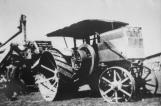14
The steamer was not long lived. It was mainly used for breaking sod and powering the threshing machine. Once most of the land had been broke, steam engines were mostly used for threshing.16
Imagine, if you can, that the farmer's wife has just brought the threshing crew a meal. She rests on the tongue of the wagon. The farmer and the engineer pose for the photographer in the window of the steam engine. Near the front wheel, a wooden barrel of water is ready to put out small fires that may start as a result of the wood or coal fired engine. The horses have been unhitched from the wagon and taken to water and feed after their morning labour. At the front of the steam engine, the 100 foot long belt can be seen leaving the picture to provide the power for the threshing machine.18
The large flywheel on the side of this tractor turned the 100 foot long belt that powered the threshing machine.20
A common sight was the harvest train moving to the next field. The powerful steam engine pulled the rest. Right behind it was the threshing machine. The bunk house, where the crew slept was next. Finally, the cook car, complete with wood stove and chimney, and food supplies for the crew. Last, but not least, the cow, who provided fresh milk - no refrigeration then!22
The threshing machine blew the straw and chaff into the air forming a large straw pile. Sometimes cows were herded to the piles to graze or the straw may be burned.26
The Gil Ball/A.H. Hoffman OutfitIn the fall of 1912 threshing started on September 16th and finished on November fifth. They worked ten days in September, 23 days in October and four days in November, but they did not thresh on Sundays. Starting time was usually 6:00 or 6:30 A.M. with an hour off at noon, and shut down at 6:30 or 7:00 P.M. Many of the men drove their own horses and some also supplied an extra team. Wages appear to be about $3.50 for a full day's work. As well as stock teams, there was a separator man, three or four spike pitchers, a water tank team, some coal hauling and moving of granaries. It was the job of the separator man to grease and oil the threshing machine and repair belts as required. The belts, including the long drive belt which powered the machine were repaired with leather lacing. Spike pitchers that Fall were Sam Rogers, Chafey Scears, Maly, Gust Johnson, G. Chartrand, Bill Flaig and Frank O'Neil - he also tanked water. Spiking was recognized as hard work; as the stook teams moved into place to unload into the threshing machine, the spike pitchers moved from the empty rack to the loaded one and helped to pitch in the sheaves. Thus they were climbing up and down all day. There is no record of a stock loader so the men with stook teams must have loaded by hand. Field pitchers helped to load racks and this was considered as easier job because they were always on the ground. Operating a stook loader was a skilled job; to build a load properly the back was filled first and then gradually moved forward. If sheaves were just tumbled on, the load was more difficult to stand on and to pitch off.
In total about thirty names were on the pay roll. These include some local men and farmers for whom they threshed. Their names are as follows:
Archie McDougal Sam Rogers
Chafey Siers (Sceairs ?) ---- Maly
Gust Johnson B. Freel
Frank O'Neil David Perry
Cecil Flanders Beady Alexander
Z.R. Whitford Fred Whitford
Ambrose Whitford Fredric Whitford
John Rowe Antone Caplette
Pat Caplette Louie Caplette
G. Chartrand Bill Flaig
Harry McCaw James Quirk
Melvin Shea S-9-13-23-W2
John Rains Robert Atkinson
Alex McQwen Andrew Stone
Olie Johnson Goldwin Smith
Tom Foster Howard Moore
Cecil Flanders moved to the North West Territories with his parents in 1903. They lived four miles north of present day Avonlea and moved into the new village in 1912. He later became an elevator agent for Federal Grain in Avonlea and married a local girl Davina Cochrane. They later moved to Choiceland where she worked in the telephone office. There were six children in their family.
In 1908 Melvin Shea bought NW23-13-23-W2 which was three and one half miles north of New Warren. His daughter Edith told me once that she went to school with my dad, Ken Ball, at West Lynne which was in the SE corner of SE-13-23 W2. She said that one of the reasons that they changed schools was because of problems getting there due to Spring flooding. The Sheas later moved nearer to Avonlea and the family is still a part of the community.
The separator man that Fall of 1912 was Archie McDougal; he came from Manitoba and stayed with the Caplettes. Antone Caplette and his sons Pat and Louie came from Willow Bunch. The Whitfords were from St. Victor and G. Chartrand was from Big Beaver. This information is from Rose Caplette Balaux, sister of Pat and Louie, who is now 90 years old and living in Willow Bunch.
Charges to the farmer were by the bushel threshed- wheat ten cents, oats six cents, flax twenty-five cents, and barley ten cents per bushel.
The area threshed, known as New Warren, was South and West of Gil Ball's home, Maple Point 19-13-23-W2. The New Warren post office officially opened on August 1st, 1904. Long Creek school was built there in 1905 and by 1906 the site also included a store, blacksmith shop, barn and a small butcher shop. At the time the nearest railway was the Soo line and Rouleau was about 12 miles away to the NE along the Wood Mountain Trail which ran about a mile east of New Warren. Farmers hauled their grain to Rouleau and brought home coal and lumber. In the Fall of 1911 the Canadian Northern Railway came through; Avonlea was established as New Warren disappeared from the map though not from memory.
Farmers listed in the accounts were as follows:
Beadie Alexander had the threshers on September 16, 17, and 18 in 1912 and they threshed 1940 bushels of wheat and 1664 bushels of oats. They lived at SW32-14-22-W2 just north of Maple Point. Before West Lynne School was built son Gerald went to Longview School as did Vera and Ferne Ball.
From Alexanders they moved to Sam McCaw's and worked September 19, 27, 28 and 30. At the time they threshed 4005 bushels of wheat and 200 bushels of oats; then they moved back on October 26 and 27 to do the flax - 865 bushels. Samuel and Annie McCaw were married in 1907 in Ontario. Sam brought NE 7-13-22 from the CPR in 1905 at five dollars an acre. They built the large house of moulded concrete blocks which still stands in 1911 or 1912. Sam died in 1916 and was buried in the Rouleau cemetery. His younger brother Harry, who threshed with the crew, came West in the Spring of 1911. After Sam's death, Harry and Lily Powell from Truax, who were married in 1916, moved to NE 7-13-22 where they, with their family of ten children, remained until 1935. Harry was well known for his love of skills with horses and he told wonderful stories about them. I remember how we all enjoyed his visits around the supper table at the ranch. Dad got our school horse Smoky from Harry.
B.J. and Margaret Bedford moved West from Ontario about 1902 and filed for homestead on NW 14-13-24. In 1904 he bought the SW quarter of 13-13-23 which had water and it was there that they established a farmstead. Margaret died in 1905; B.J. then remarried and they later lived in Rouleau. He died in 1919 and was buried in the Rouleau Cemetery. On September 30 and October 1 at Bedfords they threshed 1856 bushels of wheat and 2060 bushels of oats. On October 12 and 16, they threshed 3402 bushels of wheat, on the 16th and 17th they did 946 bushels of wheat and 550 bushels of oats. On the 25th they moved back from P. Hardy's and threshed 340 bushels of flax and wheat.
From October 2 to 8 the outfit worked at NW 2-13-23 and SE 3-13-23 for John Huggard. They had a good run that week - 1482 bushels of flax, 3579 bushels of wheat and 3150 bushels of oats.
John and Mary Jane Huggard were married in 1901; this was her second marriage and she had three children from her first - Gertrude, Ada, and Roy Nelson. They all came to the NWT in 1903. Drought conditions in Warren, Minnesota, where they were farming, precipitated the move. New Warren Post Office was named for their old home. The large house and barn on SE 3-13-23 were built about 1912. Roy and Lillian Nelson and family lived there after the Huggards retired and Nelsons remain in the Avonlea community. Grandma, Alice Ball, told of attending church services at Huggards over at New Warren.
James and Alice Quirk also moved from Minnesota in 1903. Alice was John Huggard's sister. They homesteaded NE 3-13-23 and moved on to B.C. about 1922. Their threshing was done October 8, 11, and 12. James was the only farmer to grow barley - 155 bushels as well as 1014 bushels of oats and 878 bushels of wheat.
On October 23, 24, and 25 for Peter Hardy they threshed 495 bushels of wheat, 700 bushels of oats and 110 bushels of flax. He must have grown flax and oats together and this was billed by time at the rate of $20.00 per hour for a total charge of $106.33. On page 266 in the Avonlea book, Mable King says her father, Jim Bennett bought SE 23-13-23 from Peter Hardy and moved there in 1913. I also found reference in the Briercrest book "Wheat Fields and Wild Roses" which tells that the pool room and barber shop built in 1920 by John Holizki in Bayard was sold to Peter Hardy, a farmer from Rouleau. His son Don operated a garage on the premises and sold it in 1923. The Hardys lived at SE 13-13-23.
The season finished on November 4 at 3 P.M. at the farm of H. Moore. On October 28 and 31 they threshed 4438 bushels of wheat. On November first they did 240 bushels of flax and on the 2nd and 4th they finished the oats - 2700 bushels. The McDougall family story in "Arrowheads to Wheatfields" says that in 1918 "they bought Howard Moore's farm two miles north of town". This would be the quarter just south of the Huggard farm site.
The total hours in operation that Fall were 316 and one half.
This information comes from Gil Ball's account book for 1912 and from the local history book for Avonlea, Hearne, and district "Arrowheads to Wheatfields". Land locations are in the R.M. of Redburn #130 which was so named for the prairie fires.
27
Livingstone and Ball, Avonlea, Sask, Threshing 19121912
A field near Avonlea, Saskatchewan, Canada







